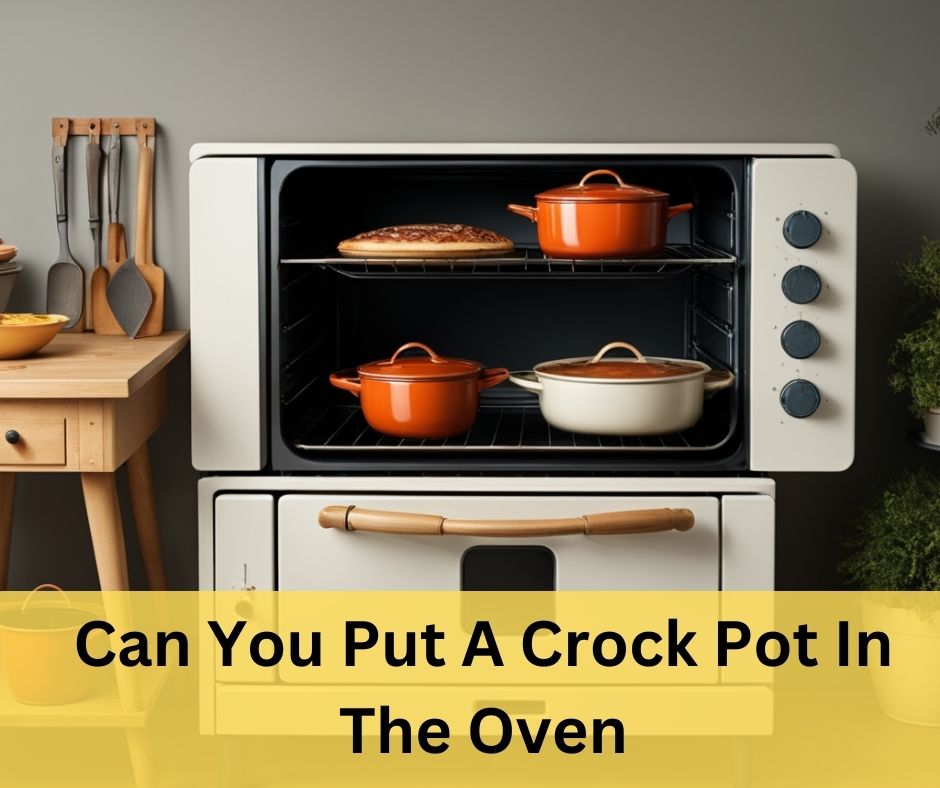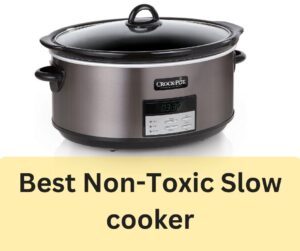Welcome to our comprehensive guide on a common kitchen conundrum: “Can you put a Crock-Pot in the oven?” If you’ve ever wondered about the compatibility of your trusty slow cooker with your oven, you’ve come to the right place. We have all the answers you need, and we’re here to simplify it for you. So, stay connected with us as we delve into the details of whether you can use your Crock-Pot in the oven and explore the essential safety considerations. But we don’t stop there; we’ll also uncover whether this method applies to other popular slow cooker brands. Whether you’re a seasoned chef or a novice in the kitchen, join us on this journey for a better understanding of the culinary possibilities right at your fingertips. Let’s get started!
Can You Put A Crock Pot In The Oven

What Is a Crock-Pot?
A Crock-Pot, often called a slow cooker, is a versatile kitchen appliance that has become a beloved staple in many households. Its primary purpose is to simplify cooking by allowing you to prepare delicious, home-cooked meals with minimal effort
What Are the Purposes of Placing the Crock-Pot in the Oven?
Placing a Crock-Pot in the oven might seem like an unconventional idea, but it serves specific purposes that can be incredibly useful for home cooks. Here, we’ll explore the key reasons why some people choose to use their Crock-Pots inside the oven:
Enhanced Browning and Crisping
While Crock-Pots excels at slow cooking and tenderizing, they may not always provide the desired level of browning and crispiness to certain dishes, such as roasts or casseroles. By transferring your slow-cooked creation to the oven for a short period, you can achieve that golden brown finish and delightful crispiness on the surface.
Finishing Touches
The oven can be your culinary ally when it comes to adding finishing touches to your slow-cooked masterpieces. For instance, broiling the top layer of a casserole or gratin can create a delightful crust, enhancing both texture and flavor.
Speeding up Cooking
Slow cookers, by design, operate at lower temperatures to achieve that gentle, slow-cooked magic. However, if you find yourself in a time crunch and need to speed up the cooking process, transferring your dish to a preheated oven at a higher temperature can help you get dinner on the table faster.
Versatility
Placing your Crock-Pot in the oven expands its versatility. It allows you to combine the precision of slow cooking with the rapid heat of the oven, giving you more control over the cooking process and the textures you want to achieve.
Convenience
Sometimes, using the oven can be more convenient than other methods. It’s especially handy when your Crock-Pot doesn’t have certain features like browning or crisping options. Transferring your dish to the oven can be a seamless way to overcome these limitations.
Saving Space
If your kitchen counter space is limited, using your Crock-Pot in the oven can help you free up valuable real estate during the cooking process. It’s a clever way to maximize your kitchen’s efficiency.
Can You Put Your Crock-Pot in the Oven?
The answer to whether you can put your Crock-Pot in the oven isn’t a simple “yes” or “no.” It depends on the specific Crock-Pot model you have and understanding the parts that are oven-safe. Let’s break it down:
-
Crock-Pot Inserts
The ceramic or stoneware insert, the part of your Crock-Pot where the food goes, is generally safe to use in the oven. These inserts are designed to withstand the heat of the oven without cracking or breaking. This is a common practice when you want to finish certain dishes in the oven for browning or crisping.
Crock-Pot Base or Housing
The base of your Crock-Pot, which contains the heating element and electrical components, is NOT oven-safe. Placing the entire Crock-Pot unit in the oven can cause damage to these components and pose a safety hazard.
Crock-Pot Lids
Most Crock-Pot lids are not oven-safe either. They are typically made of glass or plastic, which can melt or shatter at high oven temperatures. Using the Crock-Pot lid in the oven is not recommended.
Temperature Limits
Even with the oven-safe ceramic insert, it’s essential to know the temperature limits. Most Crock-Pot inserts can withstand temperatures up to 400°F (204°C) or slightly higher. Exceeding this limit may cause the insert to crack or break.
Crock-Pot Manufacturer Guidelines
To ensure safety and avoid damaging your Crock-Pot, always consult the manufacturer’s instructions and guidelines for your specific model. They may provide temperature limits and recommendations for oven use.
In conclusion, you can put your Crock-Pot in the oven, but with some important caveats. The ceramic insert is oven-safe and can be used for certain oven-cooking tasks. However, you should NEVER put the entire Crock-Pot unit or its lid in the oven. Always check your specific Crock-Pot’s temperature limits and follow the manufacturer’s recommendations to ensure safe and effective cooking.
How to Put a Crock-Pot in the Oven: Safety Guide
If you’ve ever wondered how to safely use your Crock-Pot in the oven, you’re not alone. This guide will walk you through the steps and precautions to take when using this kitchen hack. Follow these simple safety guidelines to ensure your culinary experiments go off without a hitch:
-
Check the Ceramic Insert
Before attempting to use your Crock-Pot in the oven, inspect the ceramic or stoneware insert. Ensure there are no cracks or chips, as these can compromise its heat resistance. If you spot any damage, it’s best to replace the insert.
Verify the Temperature Limits
Know the maximum oven-safe temperature for your Crock-Pot’s insert. Most can handle temperatures up to 400°F (204°C), but it’s crucial to confirm this in your product manual or on the manufacturer’s website.
Avoid Drastic Temperature Changes
Never go from the freezer or refrigerator directly into a hot oven with your Crock-Pot insert. Rapid temperature changes can lead to cracking. Always let the insert reach room temperature before placing it in a preheated oven.
Skip the Lid
Do not use the Crock-Pot’s glass or plastic lid in the oven. These materials are not oven-safe and can melt or shatter at high temperatures. Instead, use oven-safe covers made of metal or ceramic if needed.
Follow Your Recipe
Ensure your recipe specifically calls for transferring the Crock-Pot to the oven. Not all dishes benefit from this method, so make sure it’s the right choice for what you’re cooking.
Use Oven Mitts
When taking your Crock-Pot insert out of the oven, always use oven mitts or pot holders. The insert will be extremely hot, and safety is a top priority.
Monitor Cooking Times
Keep an eye on your dish when it’s in the oven. Oven cooking times can differ from slow cooker times, so be vigilant to prevent overcooking.
Cool Down Safely
After your oven-cooked masterpiece is complete, don’t place the hot Crock-Pot insert directly on a cold surface, as this can cause thermal shock and cracking. Instead, set it on a trivet or towel to cool gradually.
Clean with Care
When cleaning your Crock-Pot insert after oven use, avoid sudden temperature changes, such as rinsing it with cold water while it’s still hot. This can also lead to cracking.
Benefits of Having a Crock-Pot
A Crock-Pot, also known as a slow cooker, is more than just a kitchen appliance; it’s a culinary powerhouse that can transform the way you cook and simplify your life in various ways. Here are the detailed benefits of having a Crock-Pot in your kitchen:
-
Effortless Cooking
One of the primary advantages of a Crock-Pot is its set-and-forget nature. You can add your ingredients, set the cooking time and temperature, and let it work its magic. No constant stirring or monitoring is required. It’s perfect for busy individuals and families.
Time-Saver
Crock-Pots are time-efficient. While you’re at work, running errands, or even sleeping, your Crock-Pot is slowly cooking your meal. You return home to a house filled with delicious aromas and a ready-to-eat dinner.
Versatility
Crock-Pots are incredibly versatile. From hearty soups and stews to tender roasts and even desserts, they can handle a wide range of dishes. You can experiment with various ingredients and recipes to create culinary masterpieces.
Tenderizes Tough Cuts
Slow cooking at lower temperatures breaks down tough cuts of meat, making them tender and flavorful. It’s an excellent way to turn budget-friendly cuts into delectable meals.
Energy-Efficient
Crock-Pots are energy-efficient appliances. They use less electricity compared to traditional ovens and stovetops, which can help you save on your energy bills.
Healthier Eating
Slow cooking allows you to cook with minimal added fats and oils while preserving the nutritional value of ingredients. It’s a healthier cooking method for those watching their calorie intake.
Budget-Friendly
As mentioned earlier, Crock-Pots can make the most of budget-friendly ingredients. You can create large, satisfying meals with relatively inexpensive items like beans, legumes, and less expensive cuts of meat.
Less Kitchen Heat
Unlike ovens and stovetops, crock pots don’t generate excessive heat in your kitchen. This is especially appreciated during hot summer months when you want to keep your home cool.
Perfect for Parties
Crock-Pots are excellent for entertaining. You can prepare large batches of dips, appetizers, or main courses in advance, keeping your guests well-fed and allowing you to enjoy the party.
Easy Cleanup
Most Crock-Pot inserts are removable and dishwasher-safe, making cleanup a breeze.
Endless Recipes
There is a vast array of Crock-Pot recipes available, catering to various tastes and dietary preferences. Whether you’re a meat lover, vegetarian, or have specific dietary needs, you’ll find recipes to suit your palate.
FAQ:
Can you put a Crock-Pot in the oven?
Answer: Yes, but with precautions. Only the ceramic insert is oven-safe; the entire Crock-Pot unit, including the lid, should not go in the oven.
What is the maximum oven-safe temperature for a Crock-Pot?
Answer: Most Crock-Pot inserts can withstand temperatures up to 400°F (204°C). Check your specific model’s manual for precise limits.
Can I transfer my slow-cooked dish to the oven for browning?
Answer: Absolutely. Transferring your dish to the oven for a short time can add a desirable crispiness and finish to some recipes.
Is it safe to put the Crock-Pot lid in the oven?
Answer: No, Crock-Pot lids are not oven-safe. They are typically made of glass or plastic and can melt or shatter at high oven temperatures.
Can using a Crock-Pot in the oven be dangerous?
Answer: It can be if you don’t follow safety guidelines. Using only the oven-safe ceramic insert, adhering to temperature limits, and avoiding drastic temperature changes will help ensure safety.
Conclusion:
In conclusion, the question, “Can you put a Crock-Pot in the oven?” is one that comes with a straightforward answer: yes, but with specific precautions. While the ceramic insert is oven-safe and allows for added versatility in your cooking, it’s crucial to avoid placing the entire Crock-Pot unit or its lid in the oven to prevent damage and safety hazards. Understanding the temperature limits and following guidelines for a smooth transition from slow cooking to oven, finishing can open up a world of culinary possibilities while ensuring a safe and enjoyable cooking experience.



